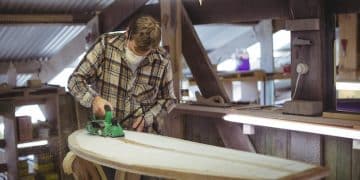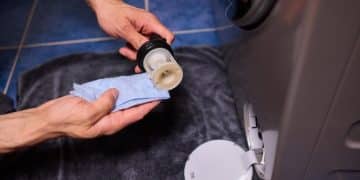DIY Home Repairs: Save Money Fixing Minor Issues Yourself
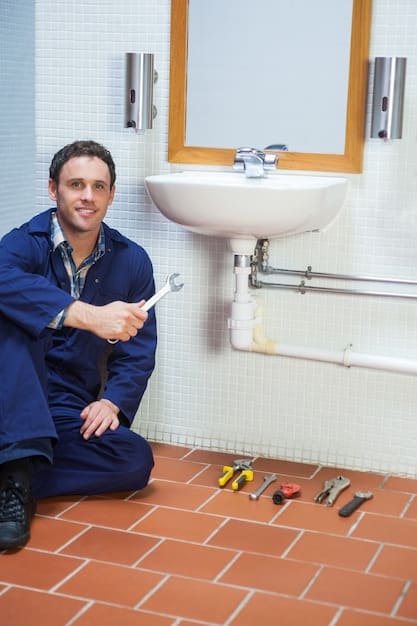
DIY home repairs empower homeowners to address minor issues independently, saving significant money on contractor fees by tackling tasks such as fixing leaky faucets, patching drywall, and unclogging drains.
Tired of calling expensive contractors for every little home repair? Discover how simple DIY home repairs can save you hundreds, empowering you to fix minor issues yourself and reclaim your budget.
Why DIY Home Repairs are a Smart Choice
Embarking on the journey of do-it-yourself home repairs can seem daunting at first, but the rewards are well worth the effort. Beyond the immediate financial savings, there are numerous compelling reasons to embrace this hands-on approach.
Understanding the benefits can empower you to confidently tackle minor home issues and transform your relationship with your living space.
Save Money on Contractor Fees
One of the most obvious and appealing benefits of DIY home repairs is the significant cost savings. Hiring a contractor for even the simplest tasks can quickly add up, with labor costs often exceeding the price of materials. By handling these repairs yourself, you eliminate the labor expense and only pay for the necessary parts and supplies.
This can be particularly beneficial for homeowners on a tight budget or those looking to allocate their funds to other home improvement projects.
Gain a Sense of Accomplishment
There’s a unique sense of satisfaction that comes from successfully completing a DIY project. From fixing a squeaky door to patching a hole in the wall, each completed task contributes to a feeling of accomplishment and pride in your home. This sense of accomplishment can be incredibly empowering and motivating, encouraging you to take on more challenging projects in the future.
You begin to see yourself as more capable and self-reliant, fostering a deeper connection with your home.
- Reduced Expenses: DIY repairs cut out labor costs, leading to significant savings.
- Skill Development: Learn valuable skills that can be applied to future projects.
- Increased Home Value: Well-maintained homes command higher resale prices.
- Personal Satisfaction: Successfully completing DIY repairs boosts confidence and pride.
In conclusion, the decision to embrace DIY home repairs is a financially sound and personally rewarding one. By taking charge of minor repairs, you not only save money but also gain valuable skills and a sense of accomplishment that enhances your connection with your home.
Essential Tools for DIY Home Repairs
Before diving into any DIY home repair project, it’s crucial to have the right tools on hand. A well-stocked toolkit can make the difference between a smooth, successful repair and a frustrating, time-consuming ordeal.
Investing in quality tools is a worthwhile investment that will pay off in the long run, enabling you to tackle a wide range of home repairs with confidence.
Basic Hand Tools
Every DIY enthusiast should have a collection of basic hand tools. These tools are fundamental for a variety of tasks and form the cornerstone of any well-equipped toolkit. Essential hand tools include:
- Screwdrivers: A set of screwdrivers with various head types (Phillips, flathead) and sizes is indispensable for tightening and loosening screws.
- Pliers: Pliers are versatile tools used for gripping, bending, and cutting wires and other materials.
- Wrench: Wrenches are essential for tightening and loosening nuts and bolts.
- Hammer: A hammer is a fundamental tool for driving nails and other fasteners.
- Measuring Tape: A measuring tape is crucial for accurate measurements.
- Level: A level is necessary for ensuring that surfaces are perfectly horizontal or vertical.
Power Tools for Efficiency
While hand tools are essential, power tools can significantly increase your efficiency and capabilities when tackling more demanding repairs. A few key power tools to consider include:
- Drill/Driver: A cordless drill/driver is invaluable for drilling holes and driving screws quickly and efficiently.
- Circular Saw: A circular saw is useful for cutting lumber and other materials.
- Sander: A sander is essential for smoothing rough surfaces and preparing them for painting or finishing.
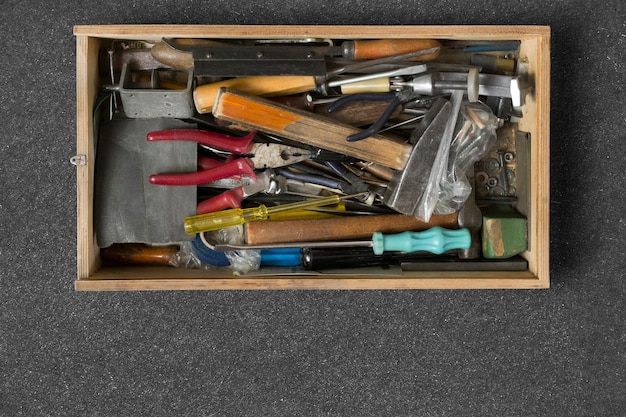
Having the right tools can transform your DIY home repair experience. It’s not just about having the tools; it’s also about knowing how to use them safely and effectively. Consider taking a basic home repair course or watching online tutorials to familiarize yourself with the proper techniques.
By assembling a well-stocked toolkit and investing time in learning basic repair skills, anyone can save lots of money.
Simple Plumbing Repairs You Can Handle
Plumbing issues can be a homeowner’s nightmare, often conjuring images of costly repairs and overflowing water. However, many common plumbing problems are surprisingly easy to fix yourself, requiring minimal tools and expertise.
By learning a few basic plumbing repair techniques, you can save money and avoid the inconvenience of waiting for a plumber.
Fixing a Leaky Faucet
A dripping faucet can be incredibly annoying and wasteful, but it’s often a simple fix. In most cases, a leaky faucet is caused by a worn-out washer or O-ring. Replacing these components is a straightforward process that can be completed in a few easy steps:
- Turn off the water supply to the faucet.
- Disassemble the faucet handle and stem.
- Remove the old washer or O-ring.
- Install a new washer or O-ring of the same size.
- Reassemble the faucet.
Unclogging a Drain
A clogged drain is another common plumbing problem that can be easily resolved without calling a plumber. Here are a couple of methods for unclogging a drain:
- Plunger: Use a plunger to create suction and dislodge the clog.
- Baking Soda and Vinegar: Pour a cup of baking soda followed by a cup of vinegar down the drain. Let it fizz for 30 minutes, then flush with hot water.
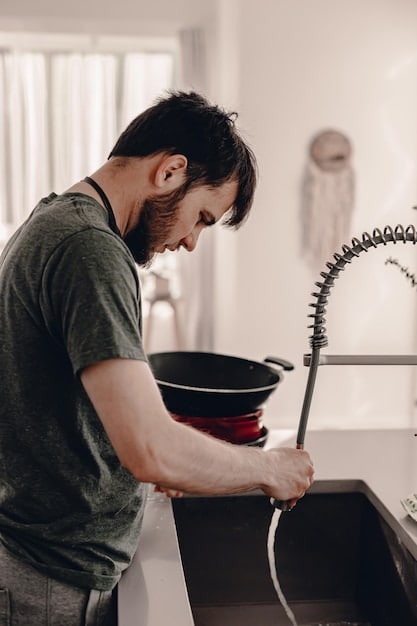
Although plumbing repairs might seem intimidating, many common issues are well within any homeowner’s capabilities. Tackle smaller projects on your own and only call a professional plumber when it is absolutely necessary.
Knowing that you can handle simple tasks can save money and give you peace of mind.
Easy Electrical Fixes for Homeowners
Electrical repairs can seem intimidating, but some basic electrical issues can be safely addressed by homeowners with a little knowledge and caution. It’s crucial to prioritize safety when working with electricity, so always turn off the power at the breaker before starting any repair.
With the right precautions, you can tackle some common electrical problems and save money on electrician fees.
Replacing a Light Switch
A faulty light switch is a common issue that can be easily resolved. Here are the steps to replacing a light switch:
- Turn off the power to the switch at the breaker.
- Remove the switch plate.
- Test the switch with a non-contact voltage tester to ensure the power is off.
- Disconnect the wires from the old switch.
- Connect the wires to the new switch, matching the connections.
- Secure the new switch in the box and replace the switch plate.
- Turn the power back on at the breaker.
Before performing any electrical fixes, it is important to follow safety precautions and seek professional help if needed. Never work on electrical projects without turning off the power breaker first, and use insulated tools.
Understanding basic electrical safety practices is essential for any DIY enthusiast. Always prioritize safety and never hesitate to call a qualified electrician if you’re unsure about any aspect of the repair.
By being cautious and informed, homeowners can safely tackle simple electrical fixes saving money.
Drywall Repair Made Simple
Drywall damage is a common occurrence in most homes, whether from accidental bumps, nail holes, or moisture damage. Fortunately, repairing drywall is a straightforward process that can be mastered by most homeowners with a little practice and the right materials.
By learning how to repair drywall, you can keep your walls looking their best and avoid the expense of hiring a professional.
- Small Nail Holes: Use spackle or joint compound to fill the hole. Allow it to dry, then sand smooth.
- Larger Holes: Cut a patch of drywall to fit the hole. Secure it with drywall screws and cover the seams with joint compound. Sand smooth.
Patching Holes in Drywall
Here are the basic materials for patching drywall:
Drywall repair can become a money saving skill when you are able to complete minor repairs on your own. This will leave you with nice looking walls without the expense.
Learning how to patch drywall can keep home looking neat and free of imperfections.
Preventative Maintenance to Avoid Future Repairs
While DIY home repairs are a great way to save money and address existing problems, preventative maintenance is key to avoiding many common home issues in the first place. By taking proactive steps to care for your home, you can extend the life of your systems and appliances, preventing costly repairs down the road.
Investing time and effort in preventative maintenance is a smart way to protect your investment and ensure a comfortable and safe living environment.
- Clean Gutters Regularly: Clogged gutters can lead to water damage to your roof and foundation.
- Inspect Plumbing for Leaks: Catching leaks early can prevent water damage and mold growth.
- Maintain Appliances: Regularly clean and service your appliances to extend their lifespan.
Preventing home issues can be a great way to save money, because you avoid having to spend funds to repair the damages that could have been prevented. This can also lower stress, preventing the headache of having to deal with major damages.
Taking care of the small things can prevent larger problems from developing and save money.
| Key Point | Brief Description |
|---|---|
| 💰 Save Money | DIY eliminates labor costs. |
| 🛠️ Essential Tools | Having the right tools for the job. |
| 🚰 Plumbing Repairs | Fixing leaks and unclogging drains. |
| 🛡️ Preventative Maintenance | Regular maintenance prevents bigger problems. |
Frequently Asked Questions
▼
Common DIY repairs include fixing leaky faucets, patching drywall holes, unclogging drains, and replacing light switches. These are generally simple and cost-effective to tackle.
▼
Essential tools include a screwdriver set, pliers, adjustable wrench, hammer, measuring tape, and level. A power drill and saw can also be helpful for more complex tasks.
▼
Check for sales and discounts at hardware stores, and consider buying used tools. For materials, only purchase the exact amount needed to avoid waste.
▼
Simple electrical repairs, like replacing a light switch, can be safe if done correctly with the power off. Always use caution, follow instructions, and call a professional if unsure.
▼
Preventative measures include regularly clearing drains, inspecting pipes for leaks, and avoiding flushing non-flushable items. Fixing minor issues early can prevent more substantial repairs.
Conclusion
Taking on DIY home repairs can be rewarding. Fixing minor issues not only saves money on contractor fees but also provides a sense of accomplishment. With the right tools and knowledge, you can confidently maintain and improve your home.



